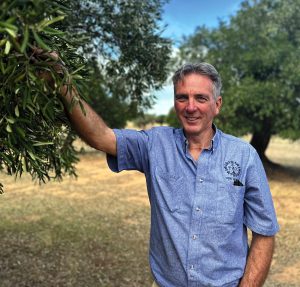Olive harvest began in the monastic town of New Norcia this month – as it has throughout the Northern Valleys region – with just a small point of difference. Unlike more modern olive groves, many of which sprung up in the 1990’s investment scheme flurry, the trees at New Norcia are as laden with history as fruit, and a wander through the original grove reveals trees which have stood for over 160 years – their gnarled roots having gripped the ground almost since the time first white settlers arrived in Western Australia.
It was Bishop Rosendo Salvado who first planted olives at New Norcia, bringing cuttings from Spain during the 1850’s when the Benedictine monks first established the mission in the bushland we now know as Victoria Plains. By the early 1900’s the grove was flourishing and providing oil not just for the monastery but also extra income, in line with the Benedictine philosophy of self-sufficiency and productivity.
Overseen by farm manager Ian Smith, the 2023 harvest hasn’t wavered much from tradition. Volunteers appear, as they do every year, giving their time to pick and gather. The investment of mechanical rakes makes short work of the larger trees, but the older trees require the same gentle hand picking they have had for a century and a half.

“These trees just give and give,” says Ian. Apart from regular pruning and thinning, mainly during September, these prolific producers require little tending and receive no irrigation even in the hot, dry wheatbelt summer. “Only what God gives us,” says Ian.
Joining the volunteers and the New Norcia staff, the monks, just six left now, spend whatever time they have between their daily tasks helping with the harvest. Working amongst them, warmly wrapped in a bright purple Dockers scarf, is Father Anscar McPhee – longtime resident of New Norcia and its sister mission Kalumburu. For Dom Anscar the old grove not only yields oil, but the space for spiritual reflection.
“I come here every Sunday and walk through the trees. There are 195 trees which to me represent the 195 countries in the world. And each leaf of those trees represents a person in need. I feel as if they are all waiting for me,” he explains, smiling broadly as he fills his backpack with the ripe green and black fruit.
Although the original olive workshop constructed in 1929 still stands nearby, intact with the crushing machinery, wooden press, sorting racks and tools used to cold-press olives up until recent times, the olives are now processed offsite for efficiency.
The utes and trailers being piled with fruit every couple of days will join others from small to medium holdings around the state in the annual pilgrimage to York where the oil is pressed in a commercial facility. Last year the New Norcia community received around 1200 litres of oil from the vintage, approximately a 10% yield. But some years it has been as much as 22% from the biennial trees.

It’s a quality oil too, winning a string of awards – one more than a century ago! A poster in the workshop reveals that in 1908 New Norcia’s olive oil won the Silver Medal at the Franco-British Exhibition in London. The tradition of quality continues to be recognised, with a Gold Medal received for the 2021 oil and no less than five awards for the 2022 vintage at the Western Australian Olives Awards. This year Ian is hoping for another good season. “Like a lot of things, these trees have improved with age!” he smiles. “Some yield more than others, but we are fortunate, we have a very good oil.”
You can buy New Norcia olive oil from the New Norcia gift shop and online at https://shop.newnorcia.com.au. Ian and New Norcia staff will also be representing the grove at the upcoming Slow Olive Festival, part of the Gidgegannup Field day on 28 May, where you can taste this hand-picked heritage for yourself!








